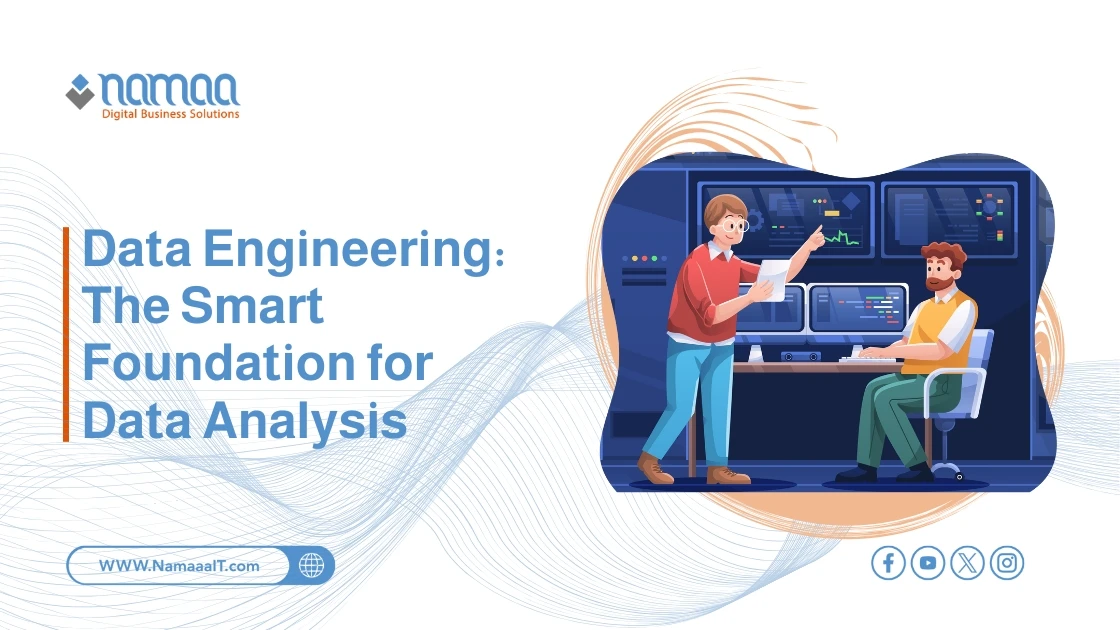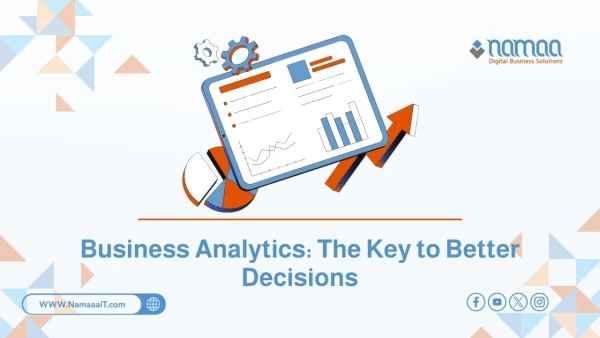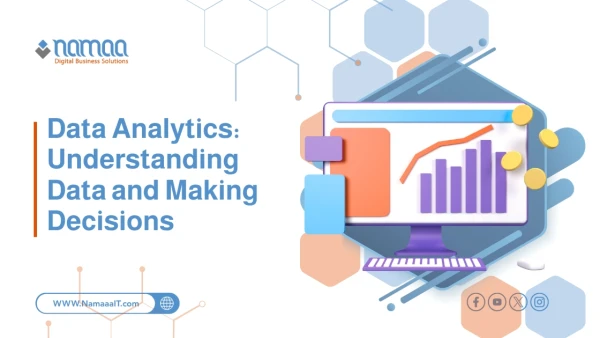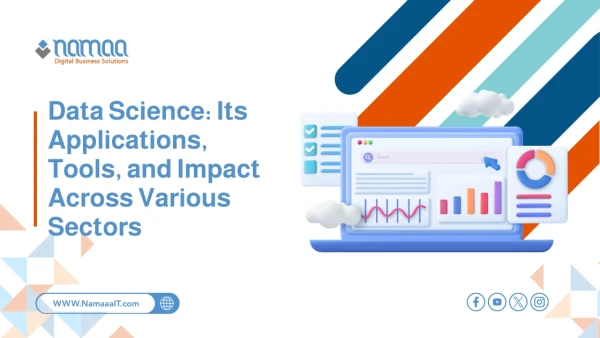Data Engineering: Transforming Raw Data into Actionable Insights
Organizations generate vast amounts of data daily, from customer interactions to internal operational details. However, this data, if not organized or processed, remains nothing but scattered numbers. This is where Data Engineering comes into play as a critical factor in turning raw data into valuable information. Data engineering is not just about storing information but also about designing and implementing systems to collect, organize, and convert data into formats that are ready for analysis and support decision-making.
What is Data Engineering?
Data Engineering is a technical discipline focused on designing and building systems that enable the collection, storage, processing, and transformation of data into a form that can be used by data analysts and data scientists. In other words, it is the infrastructure that makes data ready for use and analysis. A Data Engineer works with data from multiple sources, cleaning, standardizing, and organizing it within databases or data lakes.
Data engineers use a variety of tools and technologies, such as Apache Spark, Hadoop, and Airflow, along with programming languages like Python and SQL. The goal is to build data pipelines that automatically transfer data from its source to its final destination, whether it’s a dashboard or a machine learning model.
Data Engineering does not only focus on how data is transferred but also on its quality, integrity, and availability. It plays a crucial role in transforming data from a burden into a strategic tool that businesses can use to make informed decisions. With the increasing volume and complexity of data, Data Engineering has become an indispensable necessity in any data-driven digital environment.
The Difference Between Data Engineering and Data Analysis
Although both Data Engineering and Data Analysis rely on the same data sources, each has a completely different role in the data lifecycle. A Data Engineer is responsible for building the system that collects and prepares the data, while a Data Analyst uses that data to answer specific questions or uncover insights that can help improve performance or make strategic decisions.
You can think of a Data Engineer as the one who builds the road, while the Data Analyst is the one driving the car on that road. A Data Analyst relies on analysis tools such as Excel, Power BI, or SQL to create reports and dashboards that assist various departments within the organization. On the other hand, a Data Engineer uses more complex tools to create a robust infrastructure, such as Apache Kafka, Snowflake, or Amazon Redshift.
Another difference is in the skills: Data Analysis requires data interpretation skills and an understanding of the business domain, whereas Data Engineering requires in-depth knowledge of programming, database systems, and the flow of data through various systems. Without a strong data engineering foundation, any analysis may be inaccurate or impossible. Therefore, both roles complement each other, and each is essential for the success of any data-driven project.
read more: Business Insights
Why Do Businesses Need Data Engineering?
Organizations receive a large amount of data from various sources: mobile apps, websites, sales systems, smart devices, and more. Without an organized system to manage this data, it remains scattered, unreliable, or simply unusable. This is why businesses are increasingly relying on Data Engineering.
Data Engineering allows companies to access clean, up-to-date, and well-structured data. This data can be used in areas like enhancing customer experience, demand forecasting, performance monitoring, and trend discovery. Companies that adopt a data-engineering approach are more capable of leveraging advanced technologies like Artificial Intelligence (AI) and Machine Learning (ML), which require accurate and organized data.
Furthermore, Data Engineering helps reduce costs associated with rework, error correction, or making decisions based on incorrect information. By building automated pipelines, organizations can ensure data is continuously available and secure, supporting real-time decision-making based on actual data.
The Core Components of a Data Engineering System
An effective Data Engineering system consists of several interconnected components that work together to ensure data is collected, stored, and transformed efficiently. The first component is:
Data Sources, which can range from traditional relational databases to APIs or IoT sensors. There are Data Ingestion Tools like Apache NiFi or Kafka that are used to transport data from the source to the processing environment. Then comes the Data Transformation and Processing stage, which relies on tools like Apache Spark or dbt, where data is cleaned, merged, and standardized. Storage is also a critical element. Companies use Data Warehouses like Snowflake and BigQuery to store structured data, or Data Lakes like Amazon S3 to store unstructured data. These warehouses are built to be flexible, fast, and scalable. Data Orchestration and monitoring using tools like Airflow ensure tasks are executed in the correct order and reliably. All these components are part of an integrated system designed to provide data ready for use at any moment.
Without this infrastructure, accessing reliable data becomes difficult, and businesses lose the ability to benefit from their digital wealth.
Common ETL Tools in Data Engineering
ETL (Extract, Transform, Load) tools are a fundamental part of Data Engineering as they help extract data from different sources, process and transform it, then load it into storage repositories. There are several popular tools in this field, each with its advantages and specific use cases.
One of the most well-known tools is Apache NiFi, which provides an easy-to-use graphical interface for building complex data flows. Similarly, Apache Airflow is used for managing and scheduling ETL processes, especially when they are complex and involve multiple steps.
Another powerful tool is Talend, which offers open-source ETL solutions with advanced capabilities for data integration and synchronization across multiple systems. Informatica PowerCenter is also used in large enterprises due to its strength in handling massive and complex data sets.
For cloud environments, AWS Glue provides a fully-managed ETL solution without the need to manage servers (Serverless ETL). Google Cloud Dataflow also offers a flexible solution for processing streaming and batch data.
When choosing an ETL tool, factors such as ease of use, integration with other systems, scalability, and performance must be considered. A powerful ETL tool not only speeds up the data flow process but also enhances the quality of the final data that analysis relies on.
Data Warehouses vs Data Lakes
Data Warehouses and Data Lakes are both popular technologies for storing data, but each serves different purposes and use cases. Data Warehouses are designed to store structured data in structured tables optimized for fast queries. They are typically used to support reporting, business intelligence, and graph-based analysis.
Examples of Data Warehouses include Amazon Redshift, Google BigQuery, and Snowflake. These systems focus on query performance, strict data organization, and compatibility with query languages like SQL.
In contrast, Data Lakes like Amazon S3 and Azure Data Lake are designed to store various types of data: structured, semi-structured, and unstructured, such as video files, images, and raw text. Data Lakes are extremely flexible, making them ideal for Machine Learning projects and Big Data analytics.
The key difference is that Data Warehouses enforce a schema on write, while Data Lakes apply the schema on read, offering greater flexibility in storage.
Choosing the right system depends on the nature of the work: if the need is for fast and precise analytics, Data Warehouses are the better choice. If the priority is storing large and diverse amounts of data for future use, Data Lakes are the best option.
The Role of Cloud Computing in Data Engineering
Cloud Computing has brought a significant transformation to Data Engineering by providing a flexible and scalable environment for processing and storing vast amounts of data. Instead of relying on on-premise servers, companies can now leverage on-demand cloud resources, reducing costs and increasing operational efficiency.
One of the key roles of cloud computing in Data Engineering is providing ready-to-use tools for building data pipelines, such as AWS Glue or Google Cloud Dataflow. These tools allow data engineers to design ETL processes easily without worrying about infrastructure or maintenance.
Additionally, cloud services provide almost unlimited storage capabilities through Data Warehouses like Amazon Redshift or BigQuery, and Data Lakes like AWS S3 and Azure Data Lake. All these solutions are tightly integrated with analytical and AI tools, making it easy to transition from data collection to analysis and predictive modeling.
Cloud computing also supports data security through features like encryption, access control, and auditing. In short, having an integrated Data Engineering framework in a cloud environment means faster performance, higher flexibility, and better response to market changes or technical requirements.
Comparing AWS, Azure, and Google Cloud
When talking about cloud computing in Data Engineering, three major platforms come into play: Amazon Web Services (AWS), Microsoft Azure, and Google Cloud Platform (GCP). Each offers a set of tools and services to support the data lifecycle, but there are differences in strength, integration, and pricing.
AWS is the most mature and widespread, offering powerful solutions like AWS Glue for ETL operations, Amazon Redshift for Data Warehouses, and S3 as a Data Lake. AWS stands out with its diverse services and ease of integration, making it the ideal choice for large organizations that require scalable solutions on a global level.
Azure, on the other hand, focuses on deep integration with Microsoft services, such as SQL Server and Power BI, making it suitable for companies heavily reliant on the Microsoft ecosystem. Tools like Azure Data Factory and Azure Synapse Analytics provide robust capabilities for building and analyzing data pipelines.
Google Cloud Platform (GCP) excels in providing advanced solutions for analytics and machine learning. Google BigQuery is one of the fastest data warehouses on the market in terms of speed and performance, and it features pay-per-query pricing. GCP is also the preferred choice for teams working on AI-driven projects.
Ultimately, the platform choice depends on the project needs, data size, and the company's current infrastructure. All platforms support Data Engineering effectively, but the best option depends on practical and technical contexts for each organization.
How Data Engineering Integrates with Data Science
While Data Engineering and Data Science are different disciplines, they are closely connected in any data-driven system. Integration between the two is crucial to ensure that the data used in analytical models is accurate, up-to-date, and usable.









